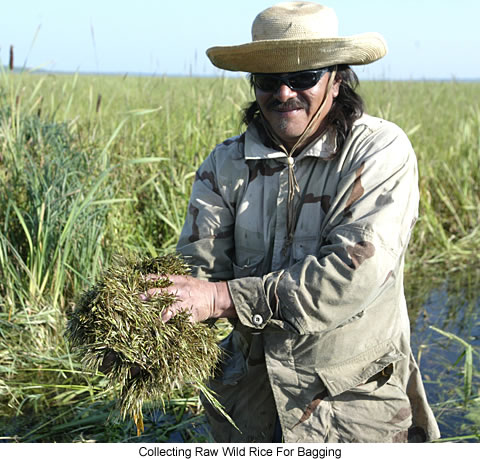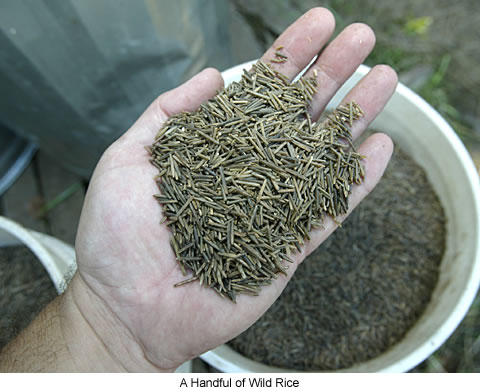 |
Canku Ota
|
 |
|
(Many Paths)
|
||
|
An Online Newsletter
Celebrating Native America
|
||
|
October 1, 2009 - Volume
7 Number 10
|
||
|
|
||
|
Bumper Harvest For
Wild Rice: Skilled Teams Shake Loose 100 Pounds Per Hour
|
||
|
by Brian Basham and
Pippi Mayfield - Detroit Lakes (MN) Tribune
|
||
|
credits: photos by Brian
Basham - Detroit Lakes (MN) newspapers
|
|
"I've never seen anything like Monday in my whole life," she said. "Everyone was coming in with boatloads (of wild rice). I'm sure glad I was here." McCradie's sons, Donald and Michael Roy of Naytahwaush, were both ricing Lower Rice Lake Monday and Tuesday. On Monday, the two ended up taking 1,028 pounds of wild rice in three boatloads, Donald Roy said. McCradie said Michael told her he never thought he'd get that much rice. "That was a workout," Donald said. The brothers were back at it Tuesday morning with more than 35 other tribal members. They expected to bring in another three boats full of green wild rice. Ricing being a rigorous task, McCradie's job was to guard the rice her sons brought into the pickup. "If I tried to rice with my boys now, they'd throw rocks at me," she said laughing. She stopped ricing about 30 years ago, when she would collect wild rice with her sister. Fifty to 60 pounds of rice back then was a good take. "If somebody came in with a full boat, you were so proud of them," she said. "But when you come in and dump your boat and go back out … jeeze!" As for her decision to come to White Earth for this year's ricing season, she said it was a very good choice. "To come out and see the rice and visit with everyone, it's the best vacation I've had in forever," she said.
"Originally, our tribe was on the East Coast," Mike Swan explained. "Because we were told to go to a place where food grows on water, that's where wild rice is. So, we migrated here." Swan, who serves as the director of natural resources for the White Earth Reservation, said the Ojibwa Indians settled here because of that wild rice and have been harvesting it since. "This year is a good year, but it's late like any agricultural crop. It's late because of the cool summer we've had," he said. The typical rice season runs from mid-August to the end of September, but this year, the ricing didn't start until after Sept. 4. "The hot sun and weather the last week has really ripened up the crop quite a bit," Swan said. The season started on Tamarac Wildlife National Refuge, with multiple lakes that offer the perfect conditions for wild rice. Ricing is only good in water about four feet deep, the water needs to be clear, and there can't be boat traffic on the lake for the rice to grow. When the refuge became established in 1938, a portion of it was on the White Earth Reservation. An agreement was made that tribal members would have priority privileges, Lowell Deede said, on the reservation portion of the refuge. Deede serves as the wildlife biologist on the Refuge.
"They then have a lottery in White Earth. For lakes that have more than five boats — for example Rice Lake had 35 boats out there — members that are drawn for ricing then select a lake chairman." The chairman then determines when the bed is ready for harvest. Deede said that's important because some ricers may try to get out early and end up ruining the crop. Other boaters can also damage the rice. "Unfortunately, the fishermen like it because it attracts bass or something like that. At that time though, the rice is still growing," Swan said. "There needs to be more education out there. Most people just see it as weeds that gives good cover for bass."
"We sell it to the employees and the elders. Some of the rice is donated to our powwows, some of the schools (receive some for students), different programs get some, and we get a lot of written donation requests for door prizes for fund-raisers." There is an order form on the whiteearth.com Web site where people can order wild rice. The tribe doesn't sell to other businesses, though, although ricers can sell it if they choose. "Usually there are others, like the White Earth Land Recovery Project, that buy rice, too, but it's been pretty quiet out there this year." Generally, Swan said, ricers use the profits from the month-and-a-half-long ricing season to supplement their income for a car, clothes, etc. "I had one guy tell me it's going to pay for their heating bill for the winter," Swan said. This year, the tribe paid $1.50 per pound for green rice, which is before it is processed.
The water is taken out of the rice, then the hulls are thrashed off the rice, then all the dust and sticks are taken out and finally, the seed remains. "That's all you have left is the finished product." Swan said the process used to be done by hand, by himself included as he was growing up, but there is equipment used now. "It wasn't easy work, I can tell you that," he said with a laugh. "It's a knack of knowing what you're doing, too. If you process your rice correctly, you should be able to save your rice up to 20 years and it should be just like it's fresh," Swan said. If the rice isn't processed correctly, it will be mush. Properly processed rice should cook up in 20 minutes.
"It's a matter of knowing what you're doing out there on the lake, what to look for and you've got to work together with your partner." During the ricing process, there are two people, one paddling and one sitting in the canoe to tap the rice into the canoe. Years ago, before Deede came to the refuge, the refuge would take 10 percent of the ricers harvest for reseeding the lakes. He said he doesn't know why that was done or why it stopped, it's just a piece of history now. "It was very labor intensive. Maybe it was thought that the beds, long-term, were able to sustain the ricing pressure without really deteriorating in size or density. This is just speculation on my part, but I think it sounds logical," he said. Deede said he knows there are non-tribal members that rice off the refuge, but in his 25 years, he can't remember a non-tribal member ricing on the refuge. Ricers are given a permit for the lake they will harvest on, and they are not permitted to "lake jump." "We have got law enforcement (officers who) check and see they are ricing on the lake they were drawn for," Deede said. "For the most part, there's not any problem with that." Once non-refuge lakes are open for ricing, the refuge lakes are open to those who did not get drawn in the lottery system. Deede said the amount of ricers depends on the growing season. There are about two bumper crops every decade, a couple busts and the remaining years are average, he said. After pondering the question, Swan said there has been a decline in ricing over the years because there are not the young ricers anymore. The average age of harvesters is 45-50, he said. There is a wild rice camp, though, that has been teaching young people to rice and he hopes to get them out on the lakes to keep the tradition alive. "A lot of times people learn from their parents, and a lot of times they're not around nowadays to take the time to teach them how to do it." And after the people are done harvesting the rice, the remainder becomes food for the waterfowl. |
|
|
||
|
|
||
| Canku Ota is a free Newsletter celebrating Native America, its traditions and accomplishments . We do not provide subscriber or visitor names to anyone. Some articles presented in Canku Ota may contain copyright material. We have received appropriate permissions for republishing any articles. Material appearing here is distributed without profit or monetary gain to those who have expressed an interest. This is in accordance with Title 17 U.S.C. Section 107. | ||
|
Canku Ota is a copyright ©
2000, 2001, 2002, 2003, 2004, 2005, 2006, 2007, 2008, 2009 of Vicki
Barry and Paul Barry.
|
||
 |
 |
|
|
The "Canku
Ota - A Newsletter Celebrating Native America" web site and
its design is the
|
||
|
Copyright ©
1999, 2000, 2001, 2002, 2003, 2004, 2005,
2006, 2007, 2008, 2009 of Paul
C. Barry.
|
||
|
All Rights Reserved.
|
||
 Ardy
McCradie of rural Grandin, N.D., came to Lower Rice Lake in Clearwater
County this year for vacation, which was just for ricing.
Ardy
McCradie of rural Grandin, N.D., came to Lower Rice Lake in Clearwater
County this year for vacation, which was just for ricing. Drawn
to the rice
Drawn
to the rice The
lucky winners
The
lucky winners On
the lake
On
the lake